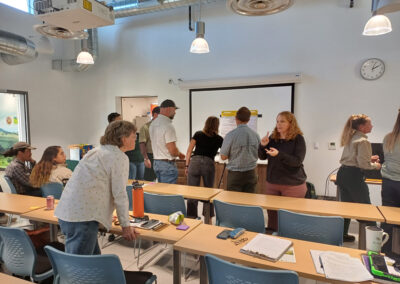The RCD of Greater San Diego County’s Regional Forest and Fire Capacity (RFFC) Program in partnership with the Southern California Montane Forest Conservation Strategy, hosted a Strategy, Vulnerabilities, and Priorities Workshop at the Santa Ysabel Nature Center. The workshop brought together stakeholders, land managers, agencies, tribal members, and residents to discuss and identify the priorities and vulnerabilities of the montane forests in San Diego County. Through collaborative exercises, attendees identified factors for forest resilience and inclusion in the analytical mapping of San Diego County.
The Southern California Montane Forest Conservation Strategy is a partnership between the Climate Science Alliance, U.S. Forest Service, Institute for Ecological Monitoring and Management at San Diego State University, and the Southwest Adaptation Science Center. Together, they are developing a regional conservation strategy for Southern California’s montane forests. To achieve this, the Southern California Forest Conservation Strategy is engaging with local stakeholders and land managers through workshops to gain their invaluable insight to properly identify the best strategies for conservation and to foster collaborative partnerships.
November’s strategy workshop was led by research Scientist Dr. Megan Jennings of San Diego State University, Province Ecologist’s Dr. Sarah Hennessy, and Nicole Molinari of the U.S. Forest Service. The workshop opened with an overview of the three key processes; the evaluation of present threats to San Diego’s montane forests, the identification of what areas to prioritize conservation, and the identification of vulnerabilities within those areas.
Participants collaborated in voting exercises to assess their conservation priorities as well as what vulnerabilities they were most concerned with. This exercise showed that among participants, the areas of greatest priority were San Diego’s old-growth forests, hydrology, biodiversity, and communities intersecting forests. In terms of vulnerabilities, fuel build-up, risk of fire regime departure, risk of type conversion, and difficulty of treatment as being of greatest concern.
Attendees then took part in a collaborative discussion to identify what conservation strategies to employ in protecting these priority areas. Among these, the need for biomass utilization emerged as a prominent strategy proposed to address fuel buildup throughout the region. In addition, a regional seed bank was also noted as being needed to aid restoration efforts.
Looking toward the future of the Southern California Montane Forest Strategy, attendees discussed how they and their respective organizations can continue to collaborate. Further engagements with agencies, such as local water districts, were planned as well as the development of a prioritization map of the assets and vulnerabilities discussed at the workshop. To aid our partners at the Southern California Montane Forest Strategy, the RCD of Greater San Diego County’s Regional Forest and Fire Capacity program invites those that manager private, state, federal, and tribal lands in the Greater Lagunas to connect and engage with us on project planning and share success stories for the upcoming California Wildfire and Forest Resilience Task Force meeting
References:
The Climate Science Alliance: Southern California Montane Forests Project



